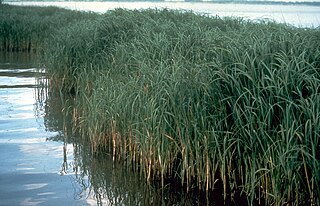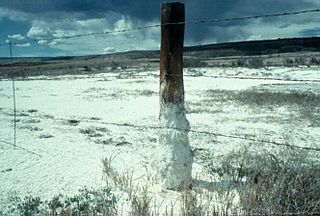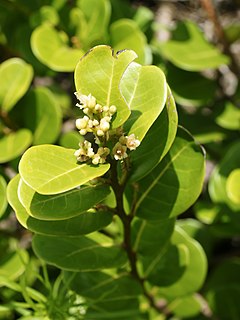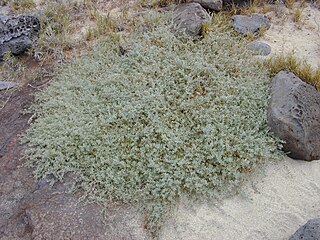Biosalinity is the study and practice of using saline (salty) water for irrigating agricultural crops.
Halotolerance is the adaptation of living organisms to conditions of high salinity. Halotolerant species tend to live in areas such as hypersaline lakes, coastal dunes, saline deserts, salt marshes, and inland salt seas and springs. Halophiles are organisms that live in highly saline environments, and require the salinity to survive, while halotolerant organisms can grow under saline conditions, but do not require elevated concentrations of salt for growth. Halophytes are salt-tolerant higher plants. Halotolerant microorganisms are of considerable biotechnological interest.

A halophyte is a salt-tolerant plant that grows in soil or waters of high salinity, coming into contact with saline water through its roots or by salt spray, such as in saline semi-deserts, mangrove swamps, marshes and sloughs and seashores. The word derives from Ancient Greek ἅλας (halas) 'salt' and φυτόν (phyton) 'plant'. Halophytes have different anatomy, physiology and biochemistry than glycophytes. An example of a halophyte is the salt marsh grass Spartina alterniflora. Relatively few plant species are halophytes—perhaps only 2% of all plant species. Information about many of the earth's halophytes can be found in the ehaloph database.

Soil salinity is the salt content in the soil; the process of increasing the salt content is known as salinization. Salts occur naturally within soils and water. Salination can be caused by natural processes such as mineral weathering or by the gradual withdrawal of an ocean. It can also come about through artificial processes such as irrigation and road salt.

Hypericum calycinum is a species of prostrate or low-growing shrub in the flowering plant family Hypericaceae. Widely cultivated for its large yellow flowers, its names as a garden plant include Rose-of-Sharon in Britain and Australia, and Aaron's beard, great St-John's wort, creeping St. John's wort and Jerusalem star. Grown in Mediterranean climates, widely spread in the Strandja Mountains along the Bulgarian and Turkish Black Sea coast, and also in Flanders in Belgium.

Chrysobalanus icaco, the cocoplum, paradise plum, abajeru or icaco, is a low shrub or bushy tree found near sea beaches and inland throughout tropical Africa, tropical Americas and the Caribbean, and in southern Florida and the Bahamas. An evergreen, it is also found as an exotic species on other tropical islands, where it has become a problematic invasive. Although taxonomists disagree on whether Chrysobalanus icaco has multiple subspecies or varieties, it is recognized as having two ecotypes, described as an inland, much less salt-tolerant, and more upright C. icaco var. pellocarpus and a coastal C. icaco var. icaco. Both the ripe fruit of C. icaco, and the seed inside the ridged shell it contains, are considered edible.

Avicennia germinans, the black mangrove, is a shrub or small tree growing up to 12 meters in the acanthus family, Acanthaceae. It grows in tropical and subtropical regions of the Americas, on both the Atlantic and Pacific Coasts, and on the Atlantic Coast of tropical Africa, where it thrives on the sandy and muddy shores where seawater reaches. It is common throughout coastal areas of Texas and Florida, and ranges as far north as southern Louisiana and coastal Georgia in the United States.

Atriplex semibaccata, commonly known as Australian saltbush, berry saltbush, or creeping saltbush, is a species of flowering plant in the family Amaranthaceae and is endemic to Australia. It is a perennial herb native to Western Australia, South Australia, Queensland and New South Wales, but has been introduced into other states and to overseas countries. It flowers and fruits in spring, and propagates from seed when the fruit splits open. This species of saltbush is adapted to inconsistent rainfall, temperature and humidity extremes and to poor soil. It is used for rehabilitation, medicine, as a cover crop and for fodder. Its introduction to other countries has had an environmental and economic impact on them.

Cakile maritima, sea rocket or European searocket, is a common plant in the mustard family Brassicaceae. It is widespread in Europe, North Africa and western Asia, especially on coastlines. It can now be found in many other areas of the world where it has been introduced. It is present on the west and east coasts of North America, where it has the potential to become an invasive species. This is an annual plant which grows in clumps or mounds in the sand on beaches and bluffs. The shiny leaves are fleshy, green and tinted with purple or magenta, and long-lobed. It has white to light purple flowers and sculpted, segmented, corky brown fruits one to three centimetres long. The fruits float and are water-dispersed.

Atriplex cinerea, commonly known as grey saltbush, coast saltbush, barilla or truganini, is a plant species in the family Amaranthaceae. It occurs in sheltered coastal areas and around salt lakes in the Australian states of Western Australia, South Australia, Tasmania, Victoria and New South Wales.

Salicornia quinqueflora, synonym Sarcocornia quinqueflora, commonly known as beaded samphire, bead weed, beaded glasswort or glasswort, is a species of succulent halophytic coastal shrub. It occurs in wetter coastal areas of Australia and New Zealand.

Frankenia pauciflora, the common sea-heath or southern sea-heath, is an evergreen shrub native to southern Australia. It is part of the Frankenia genus of the Frankeniaceae family.

Leucopogon parviflorus, commonly known as coast beard-heath or native currant, is a shrub or small tree in the family Ericaceae. It is native to all Australian states and territories excluding the Northern Territory and the ACT and also grows in New Zealand. The species can grow to between 1 and 5 metres in height and has leaves that are 11 to 29 mm long and 2.4 to 7.5 mm in width, often with curved tips. The white flowers are around 15 mm long and are produced in spikes of 7 to 13. These occur throughout the year.

Nitraria retusa, commonly known as Nitre bush, is a salt-tolerant and drought-resistant shrub in the family Nitrariaceae. It can grow to heights of 2.5 metres, although it seldom exceeds more than 1 m in height. It produces small white/green coloured flowers and small edible red fruit. The plant is native to desert areas of northern Africa, where it grows in primary succession on barren sand dunes, and in areas with high salinities such as salt marshes.

Batis maritima, the saltwort or beachwort, is a halophyte. It is a C3-plant, long-lived perennial, dioecious, succulent shrub. The plant forms dense colonies in salt marshes, brackish marshes, and mangrove swamps and frequently is found on the margins of saltpans and wind-tidal flats. Batis maritima is a pioneer plant, covers quickly areas where hurricanes have destroyed the natural vegetation.
Suaeda fruticosa is a species of flowering plant in the family Amaranthaceae. It is a small shrub, with very variable appearance over its wide range. It is a halophyte, and occurs in arid and semi-arid saltflats, salt marshes and similar habitats.

Limoniastrum monopetalum, is a species of flowering plant in the family Plumbaginaceae that is native to between Europe, Northern Africa and Western Asia. It has been found in salt marshes, dunes and other coastal areas with high salinity levels. It has silver-grey or light green leaves on multi branching stems. At the ends of the stems are the summer blooming flowers, in shades of pink, purple, lavender and violet. It is known to be salt and drought tolerant, as well as having the ability to withstand some forms of soil pollution.

Arthrocaulon macrostachyum, synonym Arthrocnemum macrostachyum, is a species of flowering plant in the amaranth family. It is native to coastal areas of the Mediterranean Sea and the Red Sea and parts of the Middle East, where it grows in coastal and inland salt marshes, alkali flats, and other habitats with saline soils.
Crop tolerance to seawater is the ability of an agricultural crop to withstand the high salinity induced by irrigation with seawater, or a mixture of fresh water and seawater. There are crops that can grow on seawater and demonstration farms have shown the feasibility. The government of the Netherlands reports a breakthrough in food security as specific varieties of potatoes, carrots, red onions, white cabbage and broccoli appear to thrive if they are irrigated with salt water.

Biosaline agriculture is the production and growth of plants in saline rich groundwater and/or soil. In water scarce locations, salinity poses a serious threat to agriculture due to its toxicity to most plants. Abiotic stressors such as salinity, extreme temperatures, and drought make plant growth difficult in many climate regions. Integration of biosaline solutions is becoming necessary in arid and semiarid climates where freshwater abundance is low and seawater is ample. Salt-tolerant plants that flourish in high-salinity conditions are called halophytes. Halophyte implementation has the potential to restore salt-rich environments, provide for global food demands, produce medicine and biofuels, and conserve fresh water.



















